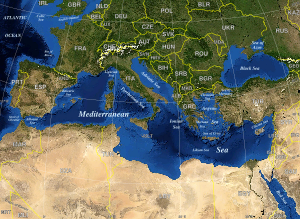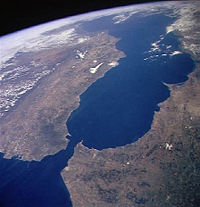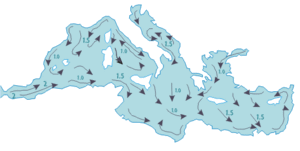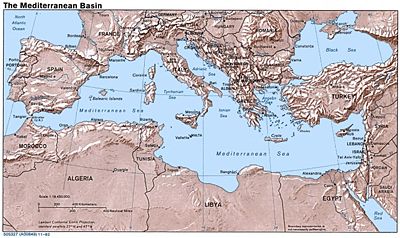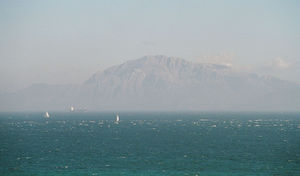Mediterranean Sea
2008/9 Schools Wikipedia Selection. Related subjects: Geography
The Mediterranean is a sea of the Atlantic Ocean surrounded by the Mediterranean region and almost completely enclosed by land: on the north by Europe, on the south by Africa, and on the east by Asia. It covers an approximate area of 2.5 million km² (965,000 sq mi), but its connection to the Atlantic (the Strait of Gibraltar) is only 14 km (9 mi) wide. In oceanography, it is sometimes called the Eurafrican Mediterranean Sea or the European Mediterranean Sea to distinguish it from mediterranean seas elsewhere.
It was an important route for merchants and travelers of ancient times, allowing for trade and cultural exchange between emergent peoples of the region — the Mesopotamian, Egyptian, Semitic, Persian, Phoenician, Carthaginian, Greek, Levantine, Roman and Moorish cultures. The history of the Mediterranean region is crucial to understanding the origins and development of many modern societies.
Name
The term Mediterranean derives from the Latin word mediterraneus, meaning "in the middle of earth" (medius, "middle" + terra, "land, earth"). This is due to the sea's being surrounded by land (especially compared to the Atlantic ocean).
The Mediterranean Sea has been known by a number of alternative names throughout human history. It was, for example, commonly called Mare Nostrum (Latin, "Our Sea") and occasionally Mare Internum by the Romans ( Sallust, Jug. 17). The Greeks name it Mesogeios (Μεσόγειος), meaning "inland, interior" (μεσο, "middle" + γαιος, "land, earth"). In the Old Testament, on the west coast of the Holy Land, and therefore behind a person facing the east, it is called the "Hinder Sea", sometimes translated as "Western Sea", ( Deut. 11:24; Joel 2:20), and also the "Sea of the Philistines" ( Exod. 22:81), because that people occupied a large portion of its shores near the Israelites. Mostly, however, it was the "Great Sea" ( Num. 34:6,7; Josh. 1:4, 9:1, 15:47; Ezek. 47:10,15,20), or simply "The Sea" ( 1 Kings 5:9; comp. 1 Macc. 14:34, 15:11). In Modern Hebrew, it is called Hayam Hatikhon (הַיָּם הַתִּיכוֹן), "the middle sea", a literal adaptation of the German equivalent Mittelmeer. In Turkish, it is Akdeniz, "the white sea". In Arabic, it is Al-Baħr Al-Abyad Al-Mutawassit (البحر الأبيض المتوسط), "the middle white sea".
History
As a sea around which some of the most ancient human civilizations were arranged, it has had a major influence on the history and ways of life of these cultures. It provided a way of trade, colonization and war, and was the basis of life (via fishing and the gathering of other seafood) for numerous communities throughout the ages.
The combination of similar-shared climate, geology and access to a common sea has led to numerous historical and cultural connections between the ancient and modern societies around the Mediterranean.
Geography and climate
The Mediterranean Sea is connected to the Atlantic Ocean by the Strait of Gibraltar on the west and to the Sea of Marmara and the Black Sea, by the Dardanelles and the Bosporus respectively, on the east. The Sea of Marmara is often considered a part of the Mediterranean Sea, whereas the Black Sea is generally not. The 163 km (101 mi) long man-made Suez Canal in the southeast connects the Mediterranean Sea to the Red Sea.
Large islands in the Mediterranean include Cyprus, Crete, Euboea, Rhodes, Lesbos, Chios, Kefalonia and Corfu in the eastern Mediterranean; Sardinia, Corsica, Sicily, and Malta in the central Mediterranean; and Ibiza, Majorca and Minorca (the Balearic Islands) in the western Mediterranean.
The climate is typical Mediterranean climate with hot, dry summers and mild, rainy winters. Crops of the region include olives, grapes, oranges, tangerines, and cork.
Oceanography
Being nearly landlocked affects the Mediterranean Sea's properties; for instance, tides are very limited as a result of the narrow connection with the Atlantic Ocean. The Mediterranean is characterized and immediately recognized by its deep blue colour.
Evaporation greatly exceeds precipitation and river runoff in the Mediterranean, a fact that is central to the water circulation within the basin. Evaporation is especially high in its eastern half, causing the water level to decrease and salinity to increase eastward. This pressure gradient pushes relatively cool, low-salinity water from the Atlantic across the basin; it warms and becomes saltier as it travels east, then sinks in the region of the Levant and circulates westward, to spill over the Strait of Gibraltar. Thus, seawater flow is eastward in the Strait's surface waters, and westward below; once in the Atlantic, this chemically-distinct "Mediterranean Intermediate Water" can persist thousands of kilometers away from its source.
Bordering countries
Twenty-one modern states have a coastline on the Mediterranean Sea. They are:
- Europe (from west to east): Spain, France, Monaco, Italy, the island state of Malta, Slovenia, Croatia, Bosnia and Herzegovina, Montenegro, Albania, Greece, Turkey, and Cyprus.
- Asia (from north to south): Turkey, Syria, Lebanon, and Israel.
- Africa (from east to west): Egypt, Libya, Tunisia, Algeria and Morocco.
Several other territories also border the Mediterranean Sea (from west to east):
- The British overseas territory of Gibraltar
- The Spanish enclaves of Ceuta and Melilla and nearby islands
- The British sovereign base area of Akrotiri and Dhekelia
- The Palestinian National Authority
Andorra, Jordan, Portugal, San Marino, Serbia, and the Vatican City, although they do not border the sea, are often considered Mediterranean countries in a wider sense due to their Mediterranean climate, fauna and flora, and/or their cultural affinity with other Mediterranean countries.
Subdivisions
According to the International Hydrographic Organization (IHO) treaties, the Mediterranean Sea is subdivided into a number of smaller seas, each with their own designation (from west to east):
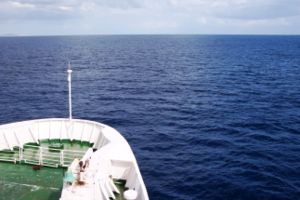
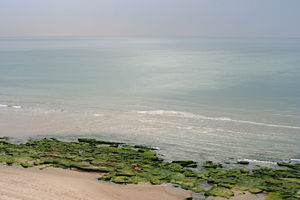
- the Alboran Sea, between Spain and Morocco,
- the Balearic Sea, between mainland Spain and its Balearic Islands,
- the Ligurian Sea between Corsica and Liguria (Italy),
- the Adriatic Sea between Italy, Slovenia, Croatia, Bosnia and Herzegovina, Montenegro and Albania
- the Ionian Sea between Italy, Greece, and Albania,
- the Aegean Sea between Greece and Turkey
- the Sea of Marmara between the Aegean and Black Sea
Other Seas
Although not recognized by the IHO treaties, there are some other seas that are in common use from the ancient times or in present:
- the Sea of Sardinia, between Sardinia and Balearic Islands, as a part of the Balearic Sea
- the Tyrrhenian Sea enclosed by Sardinia, Italian peninsula and Sicily,
- the Sea of Sicily between Sicily and Tunisia,
- the Libyan Sea between Libya and Crete,
- In the Aegean Sea,
- the Thracian Sea in its north,
- the Myrtoan Sea between the Cyclades and the Peloponnese,
- the Sea of Crete north of Crete
- the Cilician Sea between Turkey and Cyprus
Other features
Many of these smaller seas feature in local myth and folklore and derive their names from these associations. In addition to the seas, a number of gulfs and straits are also recognised:
- the Saint George Bay in Beirut, Lebanon
- the Strait of Gibraltar, connects the Atlantic Ocean to the Mediterranean Sea and separates Spain from Morocco
- the Bay of Gibraltar, at the southern end of the Iberian Peninsula
- the Gulf of Corinth, an enclosed sea between the Ionian Sea and the Corinth Canal
- the Saronic Gulf, the gulf of Athens, between the Corinth Canal and the Mirtoan Sea
- the Thermaic Gulf, the gulf of Thessaloniki, located in the northern Greek region of Macedonia
- the Kvarner Gulf, Croatia
- the Gulf of Lion, south of France
- the Gulf of Valencia, east of Spain
- the Strait of Messina, between Sicily and the toe of Italy
- the Gulf of Genoa, northwestern Italy
- the Gulf of Venice, northeastern Italy
- the Gulf of Trieste, northeastern Italy
- the Gulf of Taranto, southern Italy
- the Gulf of Salerno, southwestern Italy
- the Gulf of Gaeta, southwestern Italy
- the Gulf of Squillace, southern Italy
- the Strait of Otranto, between Italy and Albania
- the Gulf of Haifa, between Haifa and Akko, Israel
- the Gulf of Sidra, between Tunisia and Cyrenaica (eastern Libya)
- the Strait of Sicily, between Sicily and Tunisia
- the Corsica Channel, between Corsica and Italy
- the Strait of Bonifacio, between Sardinia and Corsica
- the Gulf of İskenderun, between İskenderun and Adana (Turkey)
- the Gulf of Antalya, between west and east shores of Antalya (Turkey)
- the Bay of Kotor, on the coast of Montenegro
- the Malta Channel, between Sicily and Malta
- the Gozo Channel between Malta and its sister island, Gozo
Geology
The geology of the Mediterranean is complex, involving the break-up and then collision of the African and Eurasian plates and the Messinian Salinity Crisis in the late Miocene when the Mediterranean dried up.
The Mediterranean Sea has an average depth of 1,500 metres (4,920 ft) and the deepest recorded point is 5,267 meters (about 3.27 miles) in the Calypso Deep in the Ionian Sea. The coastline extends for 46,000 kilometres (28,600 mi). A shallow submarine ridge (the Strait of Sicily) between the island of Sicily and the coast of Tunisia divides the sea in two main subregions (which in turn are divided into subdivisions), the Western Mediterranean and the Eastern Mediterranean. The Western Mediterranean covers an area of about 0.85 million km² (0.33 million sq mi) and the Eastern Mediterranean about 1.65 million km² (0.64 million sq mi).
Geodynamic
The geodynamic evolution of the Mediterranean Sea was provided by the convergence of European and African plates. This process was driven by the differential spreading along the Atlantic ridge, which led to the closure of the Tethys Ocean and eventually to the Alpine orogenesis. However, the Mediterranean also hosts wide extensional basins and migrating tectonic arcs, in response to its land-locked configuration.
Eastern Mediterranean
In middle Miocene times, the collision between the Arabian microplate and Eurasia led to the separation between the Tethys and the Indian Oceans. This process determined profound changes in the oceanic circulation patterns, which shifted global climates towards colder conditions. The Hellenic Arc, which has a land-locked configuration, underwent a widespread extension for the last 20 Myr due to a slab roll-back process. In addition, the Hellenic Arc experienced a rapid rotation phase during the Pleistocene, with a counterclockwise component in its eastern portion and a clockwise trend in the western segment.
Central Mediterranean
The opening of small oceanic basins of the central Mediterranean follows a trench migration and back-arc opening process that occurred during the last 30 Myr. This phase was characterized by the counterclockwise rotation of the Corsica-Sardinia block, which lasted until the Langhian (ca.16 Ma), and was in turn followed by a slab detachment along the northern African margin. Subsequently, a shift of this active extentional deformation led to the opening of the Tyrrenian basin.
Western Mediterranean
Since Mesozoic to Tertiary times, during convergence between Africa and Iberia, it developed the Betic-Rif mountain belts. Tectonic models for its evolution include: rapid motion of Alboran microplate, subduction zone and radial extentional collapse caused by convective removal of lithosferic mantle. The development of these intramontane Betic and Rif basins led to the onset of two marine gateways which were progressively closed during the late Miocene by an interplay of tectonic and glacio-eustatic processes.
Paleoclimatic
Because of its peculiar latitudinal position and its land-locked configuration, the Mediterranean is especially sensitive to astronomically induced climatic variations, which are well documented in its sedimentary record. Since the Mediterranean is involved in the deposition of eolian dust from the Sahara during dry periods, whereas riverine detrital input prevails during wet ones, the Mediterranean marine sapropel-bearing sequences provide high-resolution climatic information. These data have been employed in reconstructing astronomically calibrated time scales for the last 9 Ma of the earth's history. Furthermore, the exceptional accuracy of these paleoclimatic records improved our knowledge of the earth's orbital variations in the past.
Paleoenvironmental analysis
Its semi-enclosed configuration makes the oceanic gateways critical in controlling circulation and environmental evolution in the Mediterranean Sea. Water circulation patterns are driven by a number of interactive factors, such as climate and bathymetry, which can lead to precipitation of evaporites. During late Miocene times, a so-called " Messinian Salinity Crisis" (MSC hereafter) occurred, which was triggered by the closure of the Atlantic gateway. Evaporites accumulated in the Red Sea Basin (late Miocene), in the Carpatian foredeep (middle Miocene) and in the whole Mediterranean area ( Messinian). An accurate age estimate of the MSC—5.96 Ma—has recently been astronomically achieved; furthermore, this event seems to have occurred synchronously. The beginning of the MSC is supposed to have been of tectonic origin; however, an astronomical control (eccentricity) might also have been involved. In the Mediterranean basin, diatomites are regularly found underneath the evaporitic deposits, thus suggesting (albeit not clearly so far) a connection between their geneses. The present-day Atlantic gateway, i.e. the Strait of Gibraltar, finds its origin in the early Pliocene. However, two other connections between the Atlantic Ocean and the Mediterranean Sea existed in the past: the Betic Corridor (southern Spain) and the Rifian Corridor (northern Morocco). The former closed during Tortonian times, thus providing a "Tortonian Salinity Crisis" well before the MSC; the latter closed about 6 Ma, allowing exchanges in the mammal fauna between Africa and Europe. Nowadays, evaporation is more relevant than the water yield supplied by riverine water and precipitation, so that salinity in the Mediterranean is higher than in the Atlantic. These conditions result in the outflow of warm saline Mediterranean deep water across Gibraltar, which is in turn counterbalanced by an inflow of a less saline surface current of cold oceanic water.
In the last few centuries, mankind has done much to alter Mediterranean geology. Structures have been built all along the coastlines, exacerbating and rerouting erosional patterns. Many pollution-producing boats travel the sea that unbalance the natural chemical ratios of the region. Beaches have been mismanaged, and the overuse of the sea's natural and marine resources continues to be a problem. This misuse speeds along and/or confounds natural processes. The actual geography has also been altered by the building of dams and canals.
The Mediterranean was once thought to be the remnant of the Tethys Ocean. It is now known to be a structurally younger ocean basin known as Neotethys. Neotethys formed during the Late Triassic and Early Jurassic rifting of the African and Eurasian plates.
Ecology
As a result of the drying of the sea during the Messinian Salinity Crisis, the marine biota of the Mediterranean are derived primarily from the Atlantic Ocean. The North Atlantic is considerably colder and more nutrient-rich than the Mediterranean, and the marine life of the Mediterranean has had to adapt to its differing conditions in the five million years since the basin was reflooded.
The opening of the Suez Canal in 1869 created the first salt-water passage between the Mediterranean and Red Seas. The Red Sea is higher than the Eastern Mediterranean, so the canal serves as a tidal strait that pours Red Sea water into the Mediterranean. The Bitter Lakes, which are hypersaline natural lakes that form part of the canal, blocked the migration of Red Sea species into the Mediterranean for many decades, but as the salinity of the lakes gradually equalized with that of the Red Sea, the barrier to migration was removed, and plants and animals from the Red Sea have begun to colonize the Eastern Mediterranean. The Red Sea is generally saltier and more nutrient-poor than the Atlantic, so the Red Sea species have advantages over Atlantic species in the salty and nutrient-poor Eastern Mediterranean. Accordingly, Red Sea species invade the Mediterranean biota, and not vice versa; this phenomenon is known as the Lessepsian migration (after Ferdinand de Lesseps, the French engineer) or Erythrean invasion. The construction of the Aswan High Dam across the Nile River in the 1960s reduced the inflow of freshwater and nutrient-rich silt from the Nile into the Eastern Mediterranean, making conditions there even more like the Red Sea and worsening the impact of the invasive species.
Invasive species originating from the Red Sea and introduced into the Mediterranean by the construction of the canal have become a major component of the Mediterranean ecosystem and have serious impacts on the Mediterranean ecology, endangering many local and endemic Mediterranean species. Up to this day, about 300 species native to the Red Sea have already been identified in the Mediterranean Sea, and there are probably others yet unidentified. In recent years, the Egyptian government's announcement of its intentions to deepen and widen the canal have raised concerns from marine biologists, fearing that such an act will only worsen the invasion of Red Sea species into the Mediterranean, facilitating the crossing of the canal for yet additional species.
Pollution in this region has been extremely high in the past couple years. In just one year, 1,000,000 tons of sewage has been dumped directly into the Mediterranean Sea. Also, many marine species, such as the Mediterranean Monk Seal, have been almost wiped out because of the pollution there. The Monk Seal has been placed as one of the top ten endangered species in the world.
